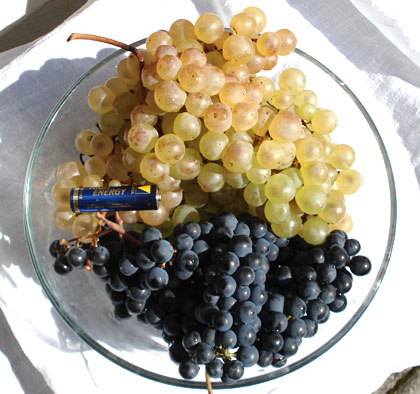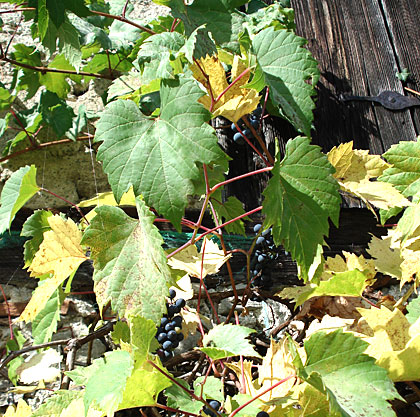Produce: Grapes

Let's start this with an important question. When you eat grapes, do you:
- Spit out the seeds and the skin (or daintily peel off the skin)
- Spit out the seeds, but eat the skin
- Swallow the seeds, leave the skin
- Eat 'em both!
I am, and have always been, no. 4. I only spit the seeds out if they are humongous, like the ones in Concord grapes. But I mentioned that I, um, swallow, to someone and they were horrified, like the seeds were doing horrible things to my gut. Why? Grape seeds are good for you, no? I've never had a tummy ache from grape seed ingestion.
Moving right along...
September to October is really a great time for a fruit maniac like me. Summer fruit like raspberries, blueberries, peaches and plums are at the tail end of their season, while fall fruits such as pears, apples and tree berries like elderberries are bursting onto the scene.
I love grapes. But honestly, who doesn't? Fresh sweet grapes are the perfect bite-size snack. Put a bowl of them besides me and I'll pop them in my mouth until they disappear. Frozen, they become mini-ice candies.
Nowadays grapes are available year-round, from greenhouses located around the globe. They all seem to grow the same boring varieties though: pale green, dark purple, and seedless variants of both, all uniform in size and appearance. Sometimes, you may encounter luscious big muscat grapes - at a premium price. But right at this time (in the temperate areas of the Northern hemisphere) is grape season, and if you are lucky, your local farmers' market may have some more unusual varieties to try. Here are two that are available at my local markets right now.

The pale grapes in this photo are Chasselas, a very old variety. The AA battery is there for size comparison - as you can see the grapes are very small compared to modern table grapes. Chasselas are a pale green-yellow in color with a little blush of wine red, and have a luminescent, translucent quality - you can see right through to the seeds. Most Chasselas end up as wine - in my limited experience, Chasselas wine is as delicate as the grapes they are made from. For eating they lack the punch of modern grapes, but I love their subtle flavor.
The dark ones are called Nostrano Americano, or just Americano, and are also used to make wine, though are more often used to make liqueurs or unfermented juice. (They have a less elegant name too - Chatzeseicherli in Swiss German, or chat-pisse in French. No idea why!) They are available at the markets, but the ones in the photo are actually from our garden. We have some old vines growing rampant up the walls of an old shed-like building in the garden. The building is about 180 years old or something, and the vines are maybe 50 years old. Obviously they like growing where they are.

We don't do anything to take care of them except to prune it back a bit, and the vines are never fed, so the grapes are quite small. But what a taste they have! They have an intense dark grape juice flavor, not the diluted grape juice taste of most modern table grapes. The skins have a tannin flavor to them which I find really nice (and I eat the skin!). I have yet to consciously encounter a wine make with just this grape though....
Chili und Ciabatta has a grape jelly recipe (in German) using Americano grapes.
So, go out to your local markets and see what unusual grapes you can find. You may never look at a boring old supermarket grape again.
If you enjoyed this article, please consider becoming my patron via Patreon. ^_^

 Welcome to Just Hungry, where we serve authentic Japanese recipes and more! I'm
Welcome to Just Hungry, where we serve authentic Japanese recipes and more! I'm 














Comments
Jul
20 September, 2006 - 20:16
Permalink
Produce: Grapes
What mouthwatering pictures! Grapes are so photogenic.
I'm usually a #2, except with a certain kind (similar to concord grapes, but I don't know what they're called). Those I spit out the skins on, too, since it keeps me from having a full-blown allergic reaction (silly, I know, but they are so yummy!).
yoko
20 September, 2006 - 20:22
Permalink
Produce: Grapes
I'm usually a #2 also. At the farmer's market where I used to live, one of the sellers told me to chew the seeds of the concord grapes. They are crunchy and emit a musky taste. I must say that I prefer seedless grapes.
My parents are the dainty ones who peel the skins and spit out the seeds!
Michelle
20 September, 2006 - 21:10
Permalink
Produce: Grapes
Gorgeous looking grapes!
Just looking at the picture, I thought those grapes really looked like the types typically used for wine-making, in those movies that feature Italy... Then I read on to the part where the grapes usually end up as wine/liquer. *blush*
I love grapes; used to pop them as snacks all the time, skin and all... Unless, of course, the seeds are humungous. Would love to be able to try those in your pic, they look delicious! ^_^
Paula
20 September, 2006 - 23:38
Permalink
Produce: Grapes
I'm with you at number 4. People do think it's weird but I guess I just grew up doing it that way.
Emily Cartier
21 September, 2006 - 06:19
Permalink
Produce: Grapes
I generally eat the skins but not the seeds. Not a strong preference tho. I'll quite happily swallow seeds... but peeling grapes just seems like a waste.
Concord and Niagra grapes grown for winemaking make *much* better eating grapes than the regular versions. I'm not sure why. They'll still be in season for a couple weeks around Lake Erie and Lake Ontario... If you're in that area, locally grown and prepared grape juice is also incredible. If you find some, you have to try it. Deep, rich, and with a lot of overtones... it puts many of the local wines to shame.
I haven't found wine grapes for sale in Southern CA tho. Sad. I know there *are* vineyards in the area, but they don't seem to ship grapes into the LA farmers markets.
maki
21 September, 2006 - 20:24
Permalink
Produce: Grapes
Further on the Americano grape...
According to this page (in German), the Americano grape was a variety that was imported from the U.S. in the later part of the 19th century, to combat the severe outbreak of Phylloxera, an insect borne disease which almost wiped out the vines in Europe. Americano was imported as root stock and to hybridize a more resistant variety. Now I am wondering if those old vines in our garden are even older than we thought, and if they were originally planted as root stock... (we live on land that used to be part of a bigger farm)...only that old building it's growing up has survived intact basically....)
maki
21 September, 2006 - 20:29
Permalink
Produce: Grapes
I love Concord grapes, whenever I am in New England I really look for them. (We could get them down in NYC/Long Island area too but the best Concords I had were definitely from more up north.)
Linda
22 September, 2006 - 09:02
Permalink
Produce: Grapes
I wish I could find seedless grapes here in France but haven't so far as I don't like to eat the seeds. My husband does. He gives me puzzled looks as I eat a pomagranate and eat the seeds. Now, that would be alot of work-not eating the seeds of a pomagranate.
Katie
23 October, 2006 - 04:01
Permalink
Produce: Grapes
In spite of the Concord grapes having the huge seeds, I always swallow them. Then again, I also eat my apple cores, so I may just be strange like that. We grow the aforementioned Concords in our backyard, and during the short time that they are in perfect condition, it is just wonderful to go out and pick off a huge clump, whether to just gorge on them unwashed right there in the yard or to take them in for fruit salad or to put in oatmeal or yogurt.
I agree that the grapes found in most supermarkets are the same dull kinds, what my father always calls "green seedless things." I had the chance to compare the taste of a similar kind at work one day, and they were indeed watery and tasteless. The ones we grow ended up being mistaken for huge blueberries by someone I work with, but I corrected him, and I think he enjoyed it. Evidently, in southern Ohio, we're just barely in the latitude where Concords will grow.
Love your site, by the way!